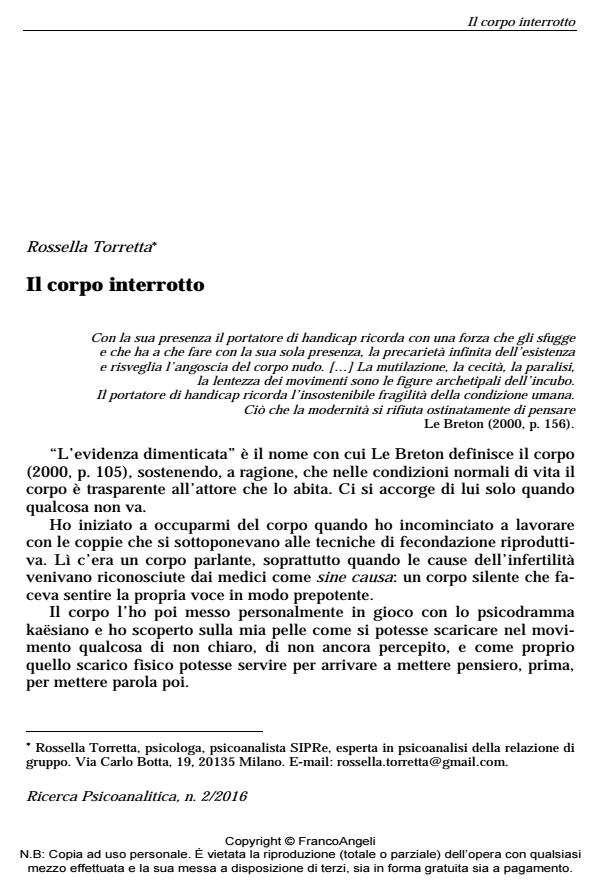The interrupted body
Journal title RICERCA PSICOANALITICA
Author/s Rossella Torretta
Publishing Year 2016 Issue 2016/2
Language Italian Pages 14 P. 45-58 File size 78 KB
DOI 10.3280/RPR2016-002004
DOI is like a bar code for intellectual property: to have more infomation
click here
Below, you can see the article first page
If you want to buy this article in PDF format, you can do it, following the instructions to buy download credits

FrancoAngeli is member of Publishers International Linking Association, Inc (PILA), a not-for-profit association which run the CrossRef service enabling links to and from online scholarly content.
Starting from individual bodies seen as means for relating and exploring the world and developing personality, the Author sees the body as a metaphor of a group and talks about his experience as leader of a group of adults that had suffered serious physical wounds. The A. suggests that these wounds can determine a breakdown in the recognition of oneself and that group work allowed these persons to work through the passage from "I am no longer", as felt after the accident, to "I still am, I can be in a different way" starting from their own bodies and finding themselves again. The lack of a part of oneself (a limb) was elaborated in the group as the mourning of what one was before, an indispensable pre-requisite for going forward and opening up again. In this article the A. reefers to Merleau-Ponty, Bion, Anzieu, Kaës and Le Breton.
Keywords: Body, group, body of group, phantom limb, non-limb
- Anzieu D. (1985). Trad. it.: L’Io-pelle. Roma: Borla, 2005.
- Avron O. (2011). L’émotionnalité partecipative: corps et psychisme en interaction. Revue de psychothérapie psychanalytique de groupe, 57: 23-33. DOI: 10.3917/rppg.057.0023
- Bion W.R. (1962a). Trad. it.: Apprendere dall’esperienza. Roma: Armando, 1972.
- Bion W.R. (1962b). A Theory of Thinking in Second Thoughts. London: Karnac.
- Bonomi F. (2004-2008). Vocabolario etimologico della Lingua Italiana.
- Chapelier J.B. (2011). Du corps individuel au corps groupal: au-delà d’une métaphore?. Revue de psychothérapie psychanalytique de groupe, 57: 9-21. DOI: 10.3917/rp-pg.057.0009
- Corbella S. (1998). Essere nel gruppo. dalla dimensione corporea a quella personale. www.psychomedia.it./pm/training/giornate/98aion/corbella.htm.
- Corbella S. (2003). Storie e luoghi del gruppo. Milano: Raffaello Cortina Editore.
- Foulkes S.H. (1964). Analisi terapeutica di gruppo. Torino: Boringhieri, 1967.
- Galimberti U. (2010). Il corpo. Milano: Universale Economica Feltrinelli.
- Kaës R. (1995). Corps/groupe: réciprocité imaginaires. Revue de psychothérapie psycha-nalytique de groupe, 25: 35-49.
- Kaës R. (2013). Il gruppo in tempo di crisi. L’approccio psicoanalitico di gruppo e il malessere nella cultura del nostro tempo. Ricerca Psicoanalitica, 1: 11-28.
- Le Breton D. (2000). Trad. it.: Antropologia del corpo e modernità. Milano: Giuffré Editore, 2007.
- Losso R. (2000). Trad. it.: Psicoanalisi della famiglia. Milano: FrancoAngeli.
- Lo Verso G., Ferrario A.M. (2013). Psicodinamica e clinica gruppo analitica: elementi di teoria e tecnica. Ricerca Psicoanalitica, 1: 29-49.
- Merleau-Ponty M. (1945). Trad. it.: Fenomenologia della percezione. Milano: Bompiani, 2003.
- Nicolle O., Kaës R., a cura di (2008). Trad. it.: L’istituzione in eredità. Miti di fondazione, trasmissione, trasformazione. Roma: Borla.
- Nietzsche F. (1883). Così parlò Zarathustra. Un libro per tutti e per nessuno. In: Opere, 1973, vol. VI, 1. Milano: Adelphi.
- Pennac D. (2012). Trad. it.: Storia di un corpo. Milano: Feltrinelli.
- Robinson B. (2010). Corps, groupe et psychodrame. Revue de psychothérapie psychanalytique de groupe, pp. 123-140. DOI: 10.3917/rppg.054.0123
- https://www.treccani.it/enciclopedia/gruppo.
- https://www.treccani.it/gruppo.
Rossella Torretta, Il corpo interrotto in "RICERCA PSICOANALITICA" 2/2016, pp 45-58, DOI: 10.3280/RPR2016-002004